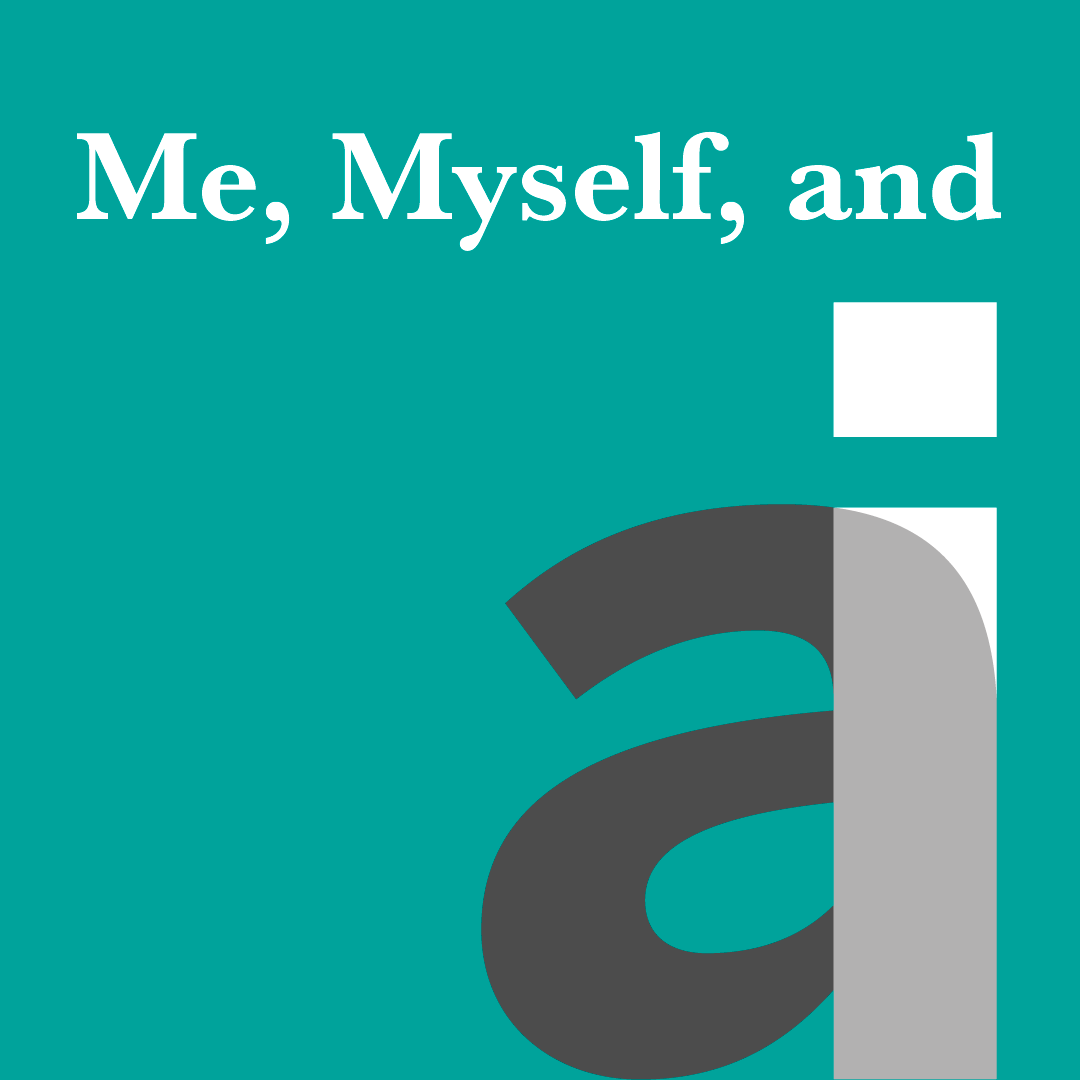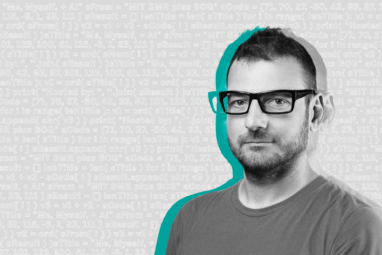Topics
Artificial Intelligence and Business Strategy
In collaboration with
BCGSpecialized teams — particularly technology teams — often face challenges as they strive to work cross-functionally, especially at legacy organizations. For Kobi Abayomi, vice president of data science at Warner Music Group, addressing such challenges starts with hiring strong talent into the technology function.
In this episode of the Me, Myself, and AI podcast, Kobi joins hosts Sam Ransbotham and Shervin Khodabandeh to explain how the music company is moving its infrastructure into the digital era, how it leverages vast amounts of consumer data to make informed decisions in an increasingly challenging landscape, and how AI is helping customers discover new music they’ll love.
Read more about our show and follow along with the series at https://sloanreview.mit.edu/aipodcast.
Subscribe to Me, Myself, and AI on Apple Podcasts, Spotify, or Google Podcasts.
Give your feedback in this two-question survey.
Transcript
Sam Ransbotham: We hear a lot about how companies can use AI to work more efficiently and improve profitability. At Warner Music Group, the company achieves those goals by helping customers discover the music they like the most. Find out how AI can help bring music to your ears in today’s episode.
Kobi Abayomi: I’m Kobi Abayomi from Warner Music Group, and you’re listening to Me, Myself, and AI.
Sam Ransbotham: Welcome to Me, Myself, and AI, the podcast on artificial intelligence in business. In each episode, we introduce you to someone innovating with AI. I’m Sam Ransbotham, professor of information systems in Boston College, and I’m also the guest editor for the AI and Business Strategy Big Ideas program at MIT Sloan Management Review.
Shervin Khodabandeh: And I’m Shervin Khodabandeh, senior partner and managing director at Boston Consulting Group.
Kobi Abayomi: Nice to meet you.
Shervin Khodabandeh: Welcome to the show.
Kobi Abayomi: Thank you.
Sam Ransbotham: Shervin and I are excited to be talking today with Kobi Abayomi, senior vice president for data science at Warner Music Group. Kobi, thanks for taking the time to join us. Welcome.
Kobi Abayomi: Yes, thank you. Thank you for having me.
Sam Ransbotham: Let’s get started. Kobi, you’ve got a new position at a new company for you, Warner Music. Can you tell us about your role?
Kobi Abayomi: Sure. I started here about a year ago. I lead the data science effort of the company. It’s a music company. And what is a music company? A music company is a support network for artists; it’s a repository for licensing rights; it’s a creator of music content. So [it’s] a modern music company — one of the three major companies. The others are Sony and Universal, and each of them probably undertakes a suite of activity that’s relatively similar, which is find new talent, maintain and monetize music that’s already been produced — both from the recorded and publishing sides — and then find other ways to monetize current and past artists, through merchandise, through licensing, through sync (that’s when music is played in other media, commercials, movies, etc.), and the stuff that we all like and enjoy: going on tours, live music, things like that. And so the company has its fingers in all parts of the music landscape.
Sam Ransbotham: Your role is senior vice president for data science, and I don’t think you mentioned the word data in there at all.
Kobi Abayomi: Sure.
Sam Ransbotham: What role does data play?
Kobi Abayomi: Let me give you the other side of the page, then. Data plays a large role. This is a legacy media company, [of] which there are many. From a data science perspective, much of the work is infrastructural. You are in an organization which did things one way and now is faced with a more competitive landscape with tech companies that [now have] their feet on the media side of the consumer space. And so a lot of the work is around infrastructure, codification, and technology, really — being able to ingest data, turn it into features, and turn it into insights that are meaningful so that the business can compete and operate now that it’s beset with a volume of data that it wasn’t before.
Much of the way money comes in the door for a music company nowadays is through digital streaming. The distribution channel is digital, right? The Spotifys and Apple Musics of the world are the ones who deliver our product directly to my listening ears — as well as your listening ears. … And we get paid for the use of that product and inventory.
And then what happens is, the data about the use of that product — which originates and is at the highest resolution on the distribution side of the channel — we get a version of it. So a lot of the things that have become pro forma in D2C [direct-to-consumer] businesses, which are recommendation systems, audience segmentation, things like that, are things now media companies — not just this company; any sort of legacy media company that has a distribution channel that’s changed from analog to digital — are now having to re-factor and re-understand: How do we understand market? How do we understand audience groups?
I’m old enough to remember and have participated in — back when I was a college student — focus groups. [Laughs.] And I remember … the college I went to, I guess I was a good focus group participant, and they kept calling me back in for different campaigns — you know, Budweiser or Hertz Rent-a-Car — and I remember being asked a bunch of different questions in a group. Well, now, with the digital consumption of things, we can augment those older methodologies of what people actually like, who they actually are, what their affinities are, what their behaviors are. And so for this company in particular — for legacy media companies in general — a lot of the data science work is around building the capacity for them to be able to enjoy what’s now available data-wise in understanding their consumers.
Sam Ransbotham: One of the challenges that Shervin and I often have is when we talk to people, they’re very narrowly focused on their particular job. And so one of the things we’re always kind of thinking about is, “How do we expand this so that everyone can relate?” because not everyone’s in the music business. But you’ve done that for us. I mean, you’ve just really laid out the challenges of legacy companies and how that applies not just with media, but … I mean, so much is digitally distributed. I think that’s an interesting broadening that you’ve already done there to explain that process.
Kobi Abayomi: Oh, well, thank you for saying that. This is the speech that I give inside the company. So everybody in the company doesn’t have an understanding of “What is data science? Why are you guys here?” And I think anybody who’s in data science is beset with that existential question.
Shervin Khodabandeh: You started by saying a lot of the challenges, given that it’s a legacy company, are infrastructural challenges, and you nicely walked us through that. But then you also talked about the axiom of existence in a legacy company for a data science team, which is a little bit of a — or maybe a lot of — a cultural and organizational challenge as well. Comment a little bit about that side of the coin.
Kobi Abayomi: Sure. I’ve been doing statistics long enough that I remember when academic departments were getting rid of their stats departments, where statistics became biostatistics, econometrics, psychometrics, and people [said], “We’ll do it ourselves. We’ll teach ourselves. We’ll teach our own service classes.” Princeton got rid of their stats department. I remember the University of Texas when they folded what they did in statistics into their industrial engineering [department]. This was all happening 20, 25 years ago. The generation of data caught up. Now we have devices that generate data, and a lot of the ideas and notions we had around large-scale computational statistics have now come to life (1) out of necessity, and (2) out of ability — that we have the ability to do these things. You can do these things on laptops; you don’t have to access the Condor mainframe and run jobs in parallel, things like that.
To now answer that in the context of business and cultural sorts of things, business is people, right? We’re lucky to organize people for similar tasks. I say this: I love cars. I remember one day having a thought: What an amazing thing a car is. Take Toyota, for instance — this large concern which spans all these different activities: We make dashboards; we make dials; we make door handles. And essentially, even in a deeper way, we turn minerals and dust into this product — regular product — where I can have a Corolla, you can have a Corolla, and they’re more or less the same. What an amazing thing to marshal so many people to get out this regular, complicated thing. In any business, you have that. You’re appealing to the Jungian zeitgeist to produce something which is coherent and then reproducible. It’s how business makes money.
In the music business, one of the challenges is the way people understand music, and how people consume it. There’s a narrative that making a hit, say, [is] just a chance thing that could happen, or idiosyncratic, or only known by the guy who’s got the cool Adidas sneakers on who’s out at the club right now. … And what I always say in having these conversations about culture: Are people predictable? Do people have patterns? And can we just pay closer attention to what we do? And that’s all really data science is, right? Writing things down, pretending that there was an experiment. From what assumptions do our actions arise? And then, how do we notice the results of those things, mediated and engaged by those assumptions?
These are the sorts of conversations that I have inside the company, that I have with people on my team. And I think one of the beautiful things about music, and why I find myself lucky to be doing data science at a music company, is that there’s resonance there. And I think people who generally have a natural inclination to this version of the art form and its complexity hear things like that and get that argument. It makes sense.
We’re trying to figure out … I’ve had this conversation with some of my colleagues at other data science groups, at other music or music distribution companies. And what, essentially, you’re trying to do is to curate more listening. I think anybody in media these days — I think when we look back at this epoch, the epitaph will be “This was the competitive area of attention” or “the era of few eyeballs and many billboards.” We’re all trying to extract a greater slice of people’s attention budget.
We’re even more advantaged because there’s a need to consume that sort of content. Your brain wants to hear something; your brain wants to hear something novel. And then the other part of it is, as people grow and audiences grow, what you’re appealing to are people’s past experiences and their experiential sort of understanding and incorporation of what they’ve heard at different times, and we can see this in consumption patterns in music. As the total addressable market of digital listeners increases, you see a tilt toward certain vintages of catalog listening. You get a population, and you give them the opportunity to listen to all sorts of stuff; turns out they want to listen to the stuff that they associate with good feelings and good times in their lives.
And so what we want to do is to really understand that interaction between a person’s affinities for certain sorts of sounds and experiences, and curate that, in a way. Some of that curation can happen from the artist as the locus, right? Like, John Mellencamp makes you feel a certain way, and you become a fan of that and very invested in that particular artist in a certain way.
This sound makes you feel a certain way. Electronic music, deep house makes you feel a certain way. And our job is to understand that well enough to be able to dynamically have the content and have it curated and delivered so that we can capture and respond to what I consider a natural desire to consume our product — music.
Shervin Khodabandeh: Very well said. And you could do it with a clear conscience.
Kobi Abayomi: That’s right. Most of the time!
Shervin Khodabandeh: You gave us a very good glimpse of why it’s purposeful and interesting to the organization and to the company to do these types of AI-driven use cases. What makes your job hard? What are some of the challenges?
Kobi Abayomi: Sure. I’ll say a couple of things. First, it’s a difficult problem as a technical thing. We have different verticals on my team dedicated to the specific legs of a stool, or understanding audiences and doing that through a mediated view of them. Again, we’re more like a B2B business than a direct-to-consumer, right? Spotify and Apple are mediating us.
How can we best understand our audiences in a dynamic and high-resolution way with the information that we have? This is where data science can add a lot of value. Our content itself — understanding our content itself in a way that’s useful for data science. Turning sound into information, and not just sound into information but the song itself. The song itself has a product from an artist. The song itself has a product from a collection of producers. The song itself has a product from a collection of musicians.
Having the data science infrastructure that allows us to encode all of this and associate in a way that we can model it and offer meaningful inference to the business. As a scientific exercise, there are a lot of interesting things that are very meaty, and I enjoy that part of it. I say that in answer to “What part is difficult?” The other part of it is — and I think this is not just speaking for what we’re doing in particular in the group that I work with but just in general — back to this need for justification of existence.
Part of what I think any data science department is going to be beset with, especially the legacy company, is satisfying the need for information product to the business while at the same time setting the business up for what the future is going to be. If you set up a data science department that just answers what’s being asked now, that’s not a useful data science department.
I’m trying to think of an example. [What] if Google had stopped at “We’re just going to do PageRank and that’s it, and we’re going to sell ads through PageRank”? Somebody asked the question, “Well, what if we had a mapping product? Well, what if we had an email product? What if we had these things?” And I’m sure to the people who were there at the business at the time in the past, these were new and novel and something that required some convincing. We were in the same position in collaboration and conversation with the business to push the frontier of what can be done, to excite their imagination on what’s possible.
Sam Ransbotham: How are you figuring out those things? How do you figure out what’s next? It seems easy enough to —
Kobi Abayomi: Yeah.
Sam Ransbotham: You hear the complaints to tell you what you should be doing right now.
Kobi Abayomi: That’s right. That’s right. [Laughs.]
Sam Ransbotham: How are you figuring out what to do and where you should be going?
Kobi Abayomi: [It’s a] work in progress. Here’s an example: This past year I had to have eye surgery, and in the beginning, the questions I might have … I was like, “Oh, I can feel something’s wrong with my eye; what needs to be done?” And so then you go to the specialist, and the specialist goes through a series of things to get to the point where, “Here, this is the outcome you want, but these are things that need to happen along the way.”
You have to be able to follow along that path of investigation with somebody who’s an expert to be able to get to the overall coarser goal. When we, in conversation with our business partners, are able to frame what they want … So an analogy: They’re the people who need the eye surgery, and at times, we’re the people who can provide a scalpel or a scleral buckle or a bubble in their retina, or whatever it is that needs to address what they’re asking for. When we’re able to have conversations like that, it’s very useful for us, because we’re able to break up where they’re trying to get to into the pieces that we know that we can construct to get there.
Those are conversations that we really enjoy having, but then, more directly, I don’t think any of us knows where this space can go and what the next frontier of music enjoyment is. I don’t think people could have predicted things like Snapchat or the proliferation of short-form video in the way that it’s very popular right now. I think we’ll all be surprised at what happens in music in concert with data science.
Some of the things that we’re excited about are things that are happening in the virtual world — Web3 sort of conversations. I had pooh-poohed virtual reality and the metaverse for a long time. I have a 12-year-old daughter; she put her VR glasses on me a couple of weeks ago. I didn’t want to take them off! I was like, “Oh my God.” And when I took them off —
Sam Ransbotham: Was that before or after your eye surgery?
Kobi Abayomi: That was after. [Laughs.] And so what that just told me is, there’s a lot of power in these new spaces and new ways that people are consuming things — gaming, the metaverse — and new ways that we can deliver experiential goods, if you will, around music that are edifying to people and grab another erg of the attention budget.
Shervin Khodabandeh: Kobi, how do you find your team? What makes a good data scientist?
Kobi Abayomi: Oh! That’s great. You know, we’re very lucky. I’ll say I’ve worked in a couple different places, and I’m lucky to have an amazing team. And I want to give credit to this company that gave me the latitude to go by some of the principles that I had figured out along the way around who you look for and who you need as a good data scientist.
I try to find a team that’s complementary. Some people are good in computational stuff. Some people are good in theoretical things. Some people are good in operations research. Some people are good in Bayesian statistics. You try to get an orthogonal basis so that you can define the space pretty well.
And then, just as far as people, I just look for people who are inquisitive. One of the nice things about hiring over the past year at Warner Music is, a lot of people who have a preternatural interest in music bubble up and [say], “Hey, wow — I didn’t know I could do music in data science,” so they’re excited about the subject matter. And those are people who’ve worked out and who’ve been fantastic and great. If you want to just level-set as far as ability, I give you a take-home problem. We have a couple different versions — they’re related to music and data science and what we’re working on — and just leave people to sit and think about them.
And then, lastly, I look for people who we can enjoy and treat each other like people and as equals. For a team like this, where the work is hard and foundational, we need a lot of collaboration. We need a lot of communication. So, good personalities, where we act with one another almost as if we were family members. A lot of these things, you know, I learned — I’ll tell you the truth — I learned as a professor finding grad students. It’s a strong relationship. It’s not quite parent-child, but it’s a very strong relationship.
Shervin Khodabandeh: Kobi, we have a new segment in the show. We’re going to ask you a few questions rapid-fire style. What’s your proudest AI moment?
Kobi Abayomi: You know, we’re turning sound into vectors of information that we can construct embeddings on. And then we look and see the topology of the space that we form after ingesting the sound. And I’ll tell you, it works. For instance, I’ve been listening to a lot of what I’ll call horn-driven, vocal, ’70s rock lately: Redbone, Chicago, groups like that. And when you look at the model that we built, you’ll get the other bands and sounds, even with all the variance and things that happened across different types of albums and different tracks, and you’ll pick out the ones that you would say, like, “Oh yeah, yeah. Right. I would listen to those guys, too.” I started listening to a lot more Hot Chocolate because of the model we use; they have this song, “Everyone’s a Winner, Baby.” That’s something that came out of constructing this model.
Shervin Khodabandeh: What’s your favorite activity that does not involve technology?
Kobi Abayomi: I like to swim. I was a swimmer for a long time. I still like to get in the water. I love it.
Sam Ransbotham: What did you want to be when you were a kid?
Kobi Abayomi: Oh! All sorts of things, but I’ll say the one that was the most salient was, I wanted to do something with cars. I wanted to design cars, make cars, make engines run. [Laughs.] I loved cars. I loved them as just complicated devices. All these things need to work in concert, you know: chemistry, thermodynamics, physics. I loved cars.
Shervin Khodabandeh: What worries you about AI?
Kobi Abayomi: People are worried about face recognition and things like that and how well that works across different groups. That’s a bit disconcerting. When you think about the underlying problem and you think about what’s likely being used underneath it, what’s likely being used underneath it is [a] neural network classifier, which likely has a strong assumption for multivariate Gaussian distribution or whatever — sort of pixilation of a face and things like that — and you think about those couple of things and you’re like, “Yeah, some things could go wrong.”
Sam Ransbotham: What are you hoping we can get from artificial intelligence in the future?
Kobi Abayomi: So this is the part that I had a little canned speech for you. So when we think of artificial intelligence, we know as practitioners that it’s not artificial intelligence, right? It’s sort of augmenting intelligence, or auxiliary. It’s intelligence that we’re creating to perform different tasks for us. And I think that that’s what we should expect from it: to release people to think about other things, right? Maybe one of the nice things if we do get self-driving down is that people have more time to read books and be introspective and read beautiful literature. And so, what I’m hoping is that we use it in ways that edify the human experience and not smash it down.
Shervin Khodabandeh: Very well said.
Sam Ransbotham: Kobi, we really enjoyed talking to you. I think you’re in an interesting space because as the production costs of music have dropped so much, it’s created so much music, but you kept using the word curate a few times, and you definitely mentioned a few times it’s an experience good — that we don’t know what music we like until we hear it. But once we’ve done that, we’ve already spent the time. And so this role of curation is very interesting, and it seems like a great application of your particular skills. Thank you for taking the time to talk with us today.
Shervin Khodabandeh: Thanks a lot for all your insights.
Kobi Abayomi: Thank you.
Sam Ransbotham: Thanks for listening. Next time, we’ll talk with Ya Xu, head of data at LinkedIn. Please join us.
Allison Ryder: Thanks for listening to Me, Myself, and AI. We believe, like you, that the conversation about AI implementation doesn’t start and stop with this podcast. That’s why we’ve created a group on LinkedIn, specifically for leaders like you. It’s called AI for Leaders, and if you join us, you can chat with show creators and hosts, ask your own questions, share insights, and gain access to valuable resources about AI implementation from MIT SMR and BCG. You can access it by visiting mitsmr.com/AIforLeaders. We’ll put that link in the show notes, and we hope to see you there.







